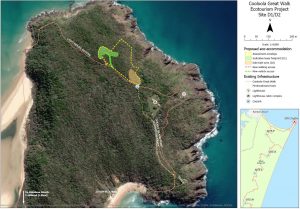Great Walk inevitable
To gain a national perspective, we interviewed Mr Miles Boak, who is now retired but worked for National Parks for thirty years in NSW, and has been involved in approval and environmental assessment of similar trails. He and his family are avid walkers trekking the Fraser Island Great Walk three times, and traversed the Cooloola Great Walk, as well as many other trails in Australia and overseas.
Mr Boak says, “There is no easy answer, and it is going to happen. Queensland is just a bit late to the party.
“Everyones doing it – New Zealand and Tasmania have led the way, the Three Capes Walk is the one held up as the flagship, because it has been a roaring success.”
He said now every state is trying to get on board – Kangaroo Island in South Australia, Light to Light in NSW… They see the market is there, in fact he states ‘Great Walks’ are a worldwide phenomenon.
Commercialisation of National Parks is not just about visitation and creating new jobs. Mr Boak explained, “There are federal and state grants to help governments with tourism infrastructure – it is a way to access money that is not necessarily available to National Parks.
“It is one of the things that is inevitable – money for environment agencies so that they can balance the budget themselves.”
The Three Capes Walk in Tasmania has two options – a $500 take your own food and sleeping bag, and you stay in a six-bedroom lodge with four or eight bunks OR a guided $2000 option where they provide food and your own exclusive lodge, with helicopters used to lighten the environmental impact at this remote location. Like Cooloola, it also involves a boat ride.
“It is fantastic having a $500 option,” said Mr Boak. “You get to sleep in a bed and you have facilities – so you aren’t roughing it. They have made the fitness level 7-10 km a day so everyone can do it.”
Eco Trails are already popular in Queensland’s Scenic Rim through World Heritage Listed Gondwana Rainforest, where a Spicers three-night walking package is $2319 per person and a seven night trail, $4880.
Other sites listed in the Queensland Government’s Ecotourism Trails program include Wangetti, linking Palm Cove with Port Douglas; on Hinchinbrook Island, near Cardwell; Whitsunday Island and Paluma Range National Park to Wallaman Falls, Australia’s tallest single drop waterfall. Two are located in the Great Barrier Reef World Heritage Area.
“If it became a famous walk, it would be great for Rainbow Beach. The NSW Green Cape Walk is based around finishing at their lighthouse. Imagine if the Cooloola walk ended at the Double Island Point lighthouse, and it was open to the public!” said Mr Boak.
He was aware that Double Island Point Lighthouse was under lease with Noosa Parks. He said it was a missed opportunity not utilising existing infrastructure of the lighthouse keeper cottages, that would create a real wow factor for paying guests.
“At the moment Cooloola Great Walk isn’t being really utilised. We did it because the one on Fraser Island always seems closed due to bushfire threat.”
Mr Boak said that when it was well done, like the Cradle Mountain Overland Track – people don’t even know it is there.
In NSW, one of the walks only proposed access at a high-end price. “It caused a bunfight, people get very emotional about it – they are afraid they will be frozen out of areas they have been camping or walking for decades.
“You need a plan that doesn’t disenfranchise locals or the Aboriginal community.” Mr Boak concluded.
“Done right and with everyone behind it, it can be really successful. The tricky thing with privatising parks, is they keep it open to the public, not just people with lots of money.”








